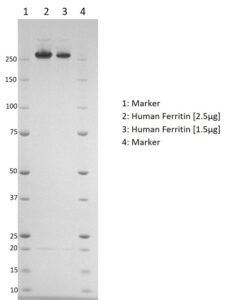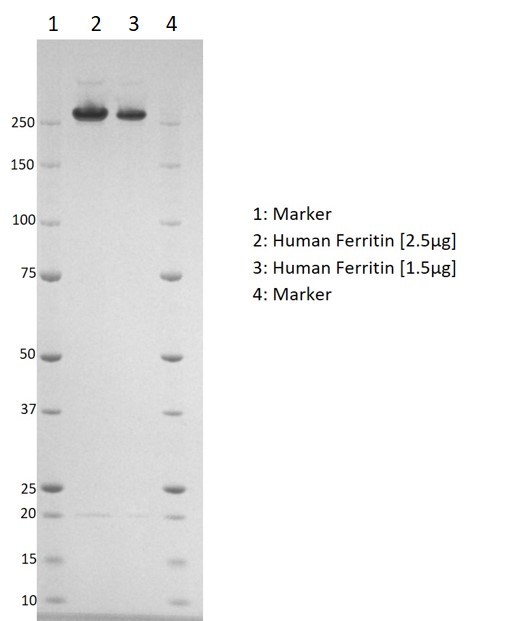
SDS-PAGE: Representative Coomassie-stained reducing SDS-PAGE showing purified human Ferritin light chain protein (REC31978).
Human Ferritin Light Chain Protein, Recombinant (HEK293)
Price range: $554.94 through $1,942.29 excl. VAT
Recombinant human ferritin light chain expressed in HEK293 cells. The protein forms a high-molecular weight homooligomer. Ferritin acts as a buffer against iron deficiency and iron overload and the amount of ferritin in the blood is directly related to the amount of iron stored in the body. In clinical medicine, ferritin is predominantly utilized as a serum marker of total body iron stores and plays a critical role in both diagnosis and management. Ferritin is also an acute-phase-protein exhibiting elevated serum concentration in various inflammatory diseases, including Covid-19.
HUMAN FERRITIN LIGHT CHAIN PROTEIN, RECOMBINANT (HEK293)
Recombinant human ferritin light chain expressed in HEK293 cells. The protein forms a high-molecular weight homooligomer. Ferritin acts as a buffer against iron deficiency and iron overload and the amount of ferritin in the blood is directly related to the amount of iron stored in the body. In clinical medicine, ferritin is predominantly utilized as a serum marker of total body iron stores and plays a critical role in both diagnosis and management. Ferritin is also an acute-phase-protein exhibiting elevated serum concentration in various inflammatory diseases, including Covid-19.
PRODUCT DETAILS – HUMAN FERRITIN LIGHT CHAIN PROTEIN, RECOMBINANT (HEK293)
- Recombinant human ferritin light chain
- Expressed in human HEK293 cells (Acc. No.: AAA35831.1)
- Purified to greater than 95% purity
- Presented as liquid in DPS
BACKGROUND
Ferritin is the cellular storage protein for iron, maintaining it in a soluble, nontoxic, readily accessible form. It forms a hollow nanocage with multiple metal–protein interactions and is essential for iron homeostasis where iron is taken up in the ferrous form and deposited as ferric hydroxides after it has been oxidized. Human ferritin is a large globular protein comprising 24 self-assembled polypeptide subunits of the heavy and light ferritin polypeptide chains. Ferritin light chain is a protein that in humans is encoded by the FTL gene and is the main intracellular iron storage protein in both prokaryotes and eukaryotes. The genes that encode the light and heavy chains are on located different chromosomes. The light chain genes are in chromosome region 19q13.3-q13.4 whilst those for the heavy chain are in chromosome region 11q12-q13.
Ferritin is expressed in most kinds of cells and co-assemble in different proportion in a tissue-specific manner, in particular in the intestinal mucosa, spleen, and liver. Changes in ferritin subunit composition influence the rates of iron uptake and release in different tissues, where a key function is the storage of iron in a soluble and nontoxic state. Ferritin that is not combined with iron is called apoferritin. In humans, Ferritin acts as a buffer against iron deficiency and iron overload and the amount of ferritin in the blood is directly related to the amount of iron stored in the body. Defects in this light chain ferritin gene are associated with several neurodegenerative diseases and hyper ferrit anemia-cataract syndrome. In clinical medicine, ferritin is predominantly utilized as a serum marker of total body iron stores and plays a critical role in both diagnosis and management (Knovich et al., 2009). Ferritin is also an acute-phase-protein exhibiting elevated serum concentration in various inflammatory diseases, including Covid-19.
REFERENCES
- Knovich MA, Storey JA, Coffman LG, Torti SV, Torti FM. Ferritin for the clinician. Blood Rev. 2009 May;23(3):95-104.

